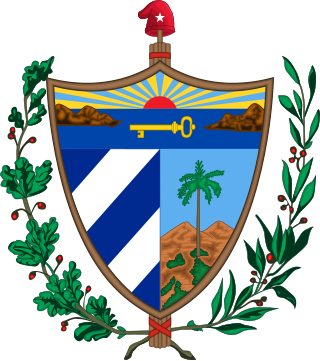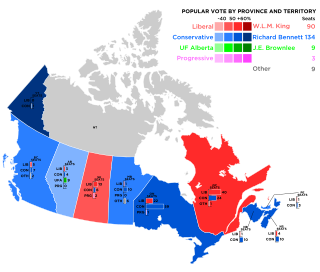Related Research Articles

Cuba has had a socialist political system since 1959 based on the "one state – one party" principle. Cuba is constitutionally defined as a Marxist–Leninist state. The present Constitution of Cuba, which was passed in a 2019 referendum, also describes the role of the Communist Party of Cuba to be the "leading force of society and of the state" and as having the capability of setting national policy, and First Secretary of the Communist Party is the most powerful position in Cuba. The 2019 Constitution of Cuba identifies the ideals represented by Cuban independence hero José Martí and revolutionary leader Fidel Castro as the primary foundation of Cuba's political system, while also stressing the importance of the influence of the ideas of Marx, Engels, and Lenin.

The 1930 Canadian federal election was held on July 28, 1930, to elect members of the House of Commons of the 17th Parliament of Canada. Richard Bedford Bennett's Conservative Party won a majority government, defeating the Liberal Party led by Prime Minister William Lyon Mackenzie King.

Elections in Cuba are held at municipal, provincial, and national levels. Cuba is a one-party state, with the Communist Party of Cuba being described as the "superior driving force of the society and the state" in the Constitution of Cuba, and the communist party is the only official political party. Elections in Cuba are not considered democratic because the government does not allow free and fair voting.

COPEI, also referred to as the Social Christian Party or Green Party, is a Christian democratic party in Venezuela. The acronym stands for Comité de Organización Política Electoral Independiente, but this provisional full name has fallen out of use. The party was influential during the twentieth century as a signatory of the Puntofijo Pact and influenced many politicians throughout Latin America at its peak.

The first Philippine Assembly elections were held across the Philippines on July 30, 1907. The Philippine Organic Act of 1902 established a bicameral Philippine Legislature composed of the appointed Philippine Commission as the upper house and the elected Philippine Assembly as the lower house.
The Partido Independiente de Color (PIC) was a Cuban political party composed almost entirely of African former slaves. It was founded in 1908 by African veterans of the Cuban War of Independence. In 1912, the PIC led a revolt in the eastern province of Oriente. The revolt was crushed and the party disbanded. It is believed Esteban Montejo, subject of Miguel Barnets "Biografía de un cimarrón," was a member of this party, or had close associates who were.

The Popular Socialist Party was a communist party in Cuba. It was founded in 1925 as the Cuban Communist Party by Blas Roca Calderio, Anibal Escalante, Fabio Grobart, Alfonso Bernal del Riesgo, and Julio Antonio Mella. Mella acted as the party's leader until his assassination in Mexico in 1929. It was later renamed the Communist Revolutionary Union in 1939. After the electoral victory of the Auténticos in the 1944 elections, the party went into decline and eventually adopted the name "Popular Socialist Party" to appeal to the electorate.
Racism in Cuba refers to racial discrimination in Cuba. In Cuba, dark skinned Afro-Cubans are the only group on the island referred to as black while lighter skinned, mixed race, Afro-Cuban mulattos are often not characterized as fully black or fully white. Race conceptions in Cuba are unique because of its long history of racial mixing and appeals to a "raceless" society. The Cuban census reports that 65% of the population is white while foreign figures report an estimate of the number of whites at anywhere from 40 to 45 percent. This is likely due to the self-identifying mulattos who are sometimes designated officially as white. A common myth in Cuba is that every Cuban has at least some African ancestry, influenced by historical mestizaje nationalism. Given the high number of immigrants from Europe in the 20th century, this is far from true. Several pivotal events have impacted race relations on the island. Using the historic race-blind nationalism first established around the time of independence, Cuba has navigated the abolition of slavery, the suppression of black clubs and political parties, the revolution and its aftermath, and the special period.
Municipal elections were held in Cuba on June 16, 1900. The elections were held under the auspices of the U.S. Military Government with a system of restricted suffrage. 7% of the Cuban population took part in the polls, which saw some important victories for pro-independence sectors.
The War of 1912, also known as the Little Race War, the Negro Rebellion, or The Twelve, was a series of protests and uprisings in 1912 in Cuba, which saw conflict between Afro-Cuban rebels and the armed forces of Cuba. It took place mainly in the eastern region of the island, where most Afro-Cubans were employed. After a weeks of fighting, including massacres of Afro-Cubans by the Cuban National Army led by General Jesus Monteagudo and a U.S. military intervention to protect American companies, the rebellion was put down. The leaders of the Afro-Cuban rebels, Evaristo Estenoz and Pedro Ivonnet, were killed during the rebellion and their political movement, The Independent Party of Color, was dissolved. Between 3,000 and 6,000 people were killed in the rebellion.

The Republic of Cuba, covering the historical period in Cuban history between 1902 and 1959, was an island country comprised the island of Cuba, as well as Isla de la Juventud and several minor archipelagos. It was located where the northern Caribbean Sea, Gulf of Mexico, and Atlantic Ocean meet. The period began in 1902 following the end of its first U.S. military occupation years after Cuba declared independence in 1898 from the Spanish Empire. This era included various changing governments and US military occupations, and ended with the outbreak of the Cuban Revolution in 1959. During this period, the United States exerted great influence on Cuban politics, notably through the Platt Amendment. The post-1959 communist government refers to this era as the "Neocolonial Republic", while many Cuban exiles refer to this period as ''Free Cuba'' as opposed to the "unfree" socialist state.

The 1898 Spanish general election was held on Sunday, 27 March and on Sunday, 10 April 1898, to elect the 8th Cortes of the Kingdom of Spain in the Restoration period. All 445 seats in the Congress of Deputies were up for election, as well as 180 of 360 seats in the Senate.

The 1896 Spanish general election was held on Sunday, 12 April and on Sunday, 26 April 1896, to elect the 7th Cortes of the Kingdom of Spain in the Restoration period. All 445 seats in the Congress of Deputies were up for election, as well as 180 of 360 seats in the Senate.

The 1893 Spanish general election was held on Sunday, 5 March and on Sunday, 19 March 1893, to elect the 6th Cortes of the Kingdom of Spain in the Restoration period. All 442 seats in the Congress of Deputies were up for election, as well as 180 of 360 seats in the Senate.

The 1886 Spanish general election was held on Sunday, 4 April and on Sunday, 25 April 1886, to elect the 4th Cortes of the Kingdom of Spain in the Restoration period. All 434 seats in the Congress of Deputies were up for election, as well as 180 of 360 seats in the Senate. The electorate comprised about 4.6% of the country's population.

The 1881 Spanish general election was held on Sunday, 21 August and on Friday, 2 September 1881, to elect the 2nd Restoration Cortes of the Kingdom of Spain. All 392 seats in the Congress of Deputies were up for election, as well as 180 of 360 seats in the Senate.

The Communist Party of Cuba is the sole ruling party of Cuba. It was founded on 3 October 1965 as the successor to the United Party of the Cuban Socialist Revolution, which was in turn made up of the 26th of July Movement and Popular Socialist Party that seized power in Cuba after the 1959 Cuban Revolution. The party governs Cuba as an authoritarian one-party state where dissidence and political opposition are prohibited and repressed. The Cuban constitution ascribes the role of the party to be the "leading force of society and of the state".

General elections were held in Paraguay on 30 April 2023 to elect the president, vice president, National Congress, and departmental governors. The incumbent president Mario Abdo Benítez and vice president Hugo Velázquez Moreno, both of the Colorado Party, were ineligible for re-election.
References
- ↑ Beard, C. A.; Hayes, C. H. (1908). "Record of Political Events". Political Science Quarterly. 23 (4): 750. doi:10.2307/2140884. ISSN 0032-3195.
- ↑ "The Restoration of Cuban Self-Government". The American Journal of International Law. 3 (2): 431–434. 1909. doi:10.2307/2186133. ISSN 0002-9300.
- ↑ "2. Cuba (1902-present)". uca.edu. Retrieved 2024-01-25.
- ↑ "CUBAN CONSERVATIVES WIN.; Show Unexpected Strength In Municipal and Provincial Elections". New York Times. 1908.
- ↑ "CLOSE ELECTIONS IN CUBA.; Miguelistas Elect 33 Mayors and the Conservatives 28". 1908.
- ↑ Eastman, Alexander Sotelo (2019). "The Neglected Narratives of Cuba's Partido Independiente de Color: Civil Rights, Popular Politics, and Emancipatory Reading Practices". The Americas. 76 (1): 41–76. doi:10.1017/tam.2018.48. ISSN 0003-1615.